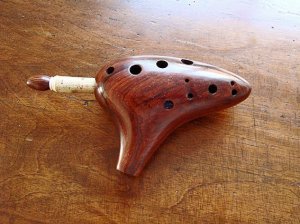
Rosewood is a common choice of wood for guitars and mandolins. It has been used for backs, sides, tops, and fretboards.
But did you know that instruments are built with several different types of rosewood? Seven of the most common are:
- Brazilian.
- Indian.
- Madagascar.
- Cocobolo.
- Amazonian.
- Honduran.
- Southeast Asian.
Does country of origin make any difference in the sound of the rosewood? Let’s examine each type in turn and find out.
Brazilian Rosewood

Brazilian rosewood, or rio as it is called by Brazilians, has earned a reputation for top-notch tone. This was largely due to influential vintage guitars built prior to 1970, many of which made extensive use of Brazilian rosewood.
However, the desirability of Brazilian rosewood subjected it to extensive overharvesting. The Brazilian government banned further exports in 1967. In 1991, it followed up with a law to prohibit the harvest of Brazilian rosewood in the wild. Rio was further protected by international treaty in 1992, making it very difficult to ship a Brazilian rosewood guitar. In 2008, the United States passed the Lacey Act, requiring a chain of paperwork to accompany rare woods arriving from other countries. This combination of laws not only makes importation of wood difficult, but it can require a musician traveling with a Brazilian rosewood guitar to carry extensive paperwork to protect his instrument from confiscation.
Guitars constructed with Brazilian rosewood still exist, however. This rare wood can be used legally if it meets one of the following criteria:
- Harvested prior to 1992.
- Cut from the stump of a tree harvested before the treaty.
- Salvaged from a naturally fallen tree.
But Brazilian rosewood remains scarce, and it commands a hefty price tag. Price, scarcity, and rich appearance (particularly one-of-a-kind in guitars made from old stumps) combine to make this wood something of a golden ideal in the guitar world, despite the variable quality that comes from salvaged wood.
Perhaps a little more ideal than its sound merits. Brazilian rosewood’s association with vintage guitars has connected it in the minds of guitarists with a warm, sweet, resonant tone. Part of this sound was owing to the availability of high-quality wood, now generally lacking. Brazilian rosewood is naturally rather hard, ever so much more so when it has been harvested from a dead stump. This translates into a guitar with excellent sound projection, but one that is a little bright and that will be prone to cracking with age. Many top luthiers claim that a warmer tonewood can be obtained by looking for a different country of origin. Much of the image of Brazilian rosewood comes from hype, which unfortunately creates a wide opening for black-market trade.
However, outstanding characteristics of Brazilian rosewood include clarity, impressive sustain, and an almost metallic resonance, often compared to the ringing of a bell. Rio can boast bright highs, but rich lows are its hallmark.
In Short
- Rare.
- Expensive.
- Often sold illegally.
- Strikingly beautiful.
- Variable quality.
- Fragile.
- Rich lows.
- Bright highs.
- Clear.
- Excellent sound projection.
- Excellent sustain.
- Resonant.
Indian Rosewood
When the Brazilian rosewood supply dwindled in the 1960s, rosewood from East India stepped up to the plate as a common wood in instrument manufacture. Although less prestigious than its rare counterpart, Indian rosewood still has a loyal following and a strong tradition in American music.
Indian rosewood has also fallen under treaty restrictions as of January 2017 in response to illegal trafficking of the wood for the Asian furniture market. These regulations are less strict than those affecting the endangered Brazilian rosewood. The new rules will require paperwork for anyone buying or selling an Indian rosewood guitar internationally. However, the treaty does not affect buying or selling Indian rosewood guitars within the borders of the United States. Under most circumstances it will not affect people traveling with the guitar.
The appearance of Indian rosewood is also less impressive than that of its Brazilian counterpart. It is brown with touches of purple and gray. Its grain tends to run in straight lines, creating a “plain” look.
While very close in weight and density to rio, Indian rosewood is just slightly the less dense of the two, diminishing its sound projection a trifle. In the hands of a novice, the difference is probably negligible. In the hands of an expert guitarist, the difference may be audible. There is an upside to the extra give of the Indian rosewood, however—it makes the guitar much sturdier and less prone to cracking with age.
Indian rosewood possesses an impressive tonal range, bringing fullness and clarity to both the low and high ends of the spectrum. It is particularly known for its bassy quality, making it a favorite with rhythm guitarists. Its sound characteristics vary somewhere between moderately warm and neutral.
In Short
- Consistent quality.
- Sturdy.
- Versatile.
- Full tonal range.
- Bassy.
- Bright highs.
- Clear.
- Resonant.
Madagascar Rosewood
Like most types of rosewood, Madagascar rosewood has a rather rather complicated history. In the 1990s, American luthiers began to experiment with this tonewood, hoping to find the perfect substitute for Brazilian rosewood. Unfortunately, civil and political turmoil in Madagascar made the supply very unreliable.
Madagascar rosewood is also rare. While it does not fall under the stringent restrictions of some of the endangered species treaties, much of it is obtained illegally and smuggled out of Africa, making it subject to confiscation if found in the United States.
This species looks very much like Brazilian rosewood, but with more of a red cast. It is a little lighter in weight, but the sound is generally regarded as similar to that of rio, albeit “livelier.” It tends to the bright side, but it does an excellent job adding richness to the entire tonal spectrum. Madagascar rosewood can also boast of superb sustain.
In Short
- Short supply.
- Often sold illegally.
- Attractive.
- Full tonal range.
- Bright.
- Excellent sustain.
Cocobolo

Cocobolo is rosewood from the Pacific Coast of Mexico and Central America. Like most other types of rosewood, its scarcity is increasing with time, and its price tag is rising to the occasion. The Mexican government is attempting to regulate the harvest of cocobolo, but an increasing amount of the wood imported to the United States has been brought in illegally.
This exotic wood has an exotic appearance to match, boasting an eye-catching rainbow of contrast somewhat reminiscent of the rich shades of Brazilian rosewood. Over time, however, cocobolo will oxidize, aging to a more uniform chocolate color.
Cocobolo is the hardest and densest of the rosewood family, which makes sound projection one of its strong suits. In fact, some luthiers feel that cocobolo is what Brazillian rosewood used to be, a throwback to the glory days of vintage guitars. Its tone is remarkably similar. The strength of cocobolo lies in the high range; it tends to lose some fullness toward the low end.
In Short
- Increasingly rare.
- Increasingly expensive.
- Often sold illegally.
- Colorful early in life.
- Projects sound well.
- Tonal range leaning toward the high end.
- Clear.
- Good sustain.
- Resonant.


